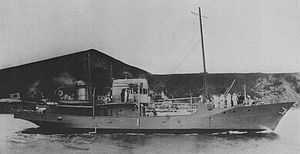No.1-class auxiliary minelayer
 Auxiliary Minelayer No.1 on 28 February 1942 | |
| Class overview | |
|---|---|
| Name: | No.1 class auxiliary minelayer |
| Builders: | Uraga Dock Company |
| Operators: |
|
| Preceded by: | Sokuten-class |
| Built: | 1941–1942 |
| In commission: | 1942–1947 |
| Planned: | 4 |
| Completed: | 4 |
| Lost: | 3 |
| Retired: | 1 |
| General characteristics | |
| Type: | Minelayer |
| Displacement: | 215 long tons (218 t) standard |
| Length: | 35.11 m (115 ft 2 in) overall |
| Beam: | 6.16 m (20 ft 3 in) |
| Draught: | 2.38 m (7 ft 10 in) |
| Propulsion: | 1 × low-speed diesel single shaft, 400 bhp |
| Speed: | 9.5 knots (10.9 mph; 17.6 km/h) |
| Range: | 1,500 nmi (2,800 km) at 9.5 kn (10.9 mph; 17.6 km/h) |
| Complement: | 63 |
| Armament: | • 1 × 76.2 mm (3.00 in) L/40 AA gun • 2 × 13 mm AA guns • 40 × Type 93 naval mines or 16 × depth charges |
The No.1 class auxiliary minelayer (第一号型敷設特務艇, Dai Ichi Gō-gata Fusetsu-Tokumutei) was a class of minelayers of the Imperial Japanese Navy (IJN), serving during World War II. They were built to supplement the timeworn Sokuten-class. 4 vessels were built in 1941–42 under the Maru Rin Programme (Ship # 257–260).
Background
- In 1939, the Sokuten-class was the main minelayer of the local guard districts. However, they were too old. The IJN wanted new small minelayers for local guard districts.
- In 1940, the IJN found out a handy boat. It was a standard longline fishing ship Sōyō Maru (160 tons) by the Ministry of Agriculture, Forestry. The IJN made a model of it and completed a design of new small minelayer. Uraga Dock Company built all of the vessels.
Ships in class
| Ship # | Ship | Laid down | Launched | Completed | Fate |
| 257 | Auxiliary minelayer No. 1[1] ex-Minelayer No. 1 |
4 June 1941 | 20 August 1941 | 28 February 1942 as Minelayer No. 1 |
Renamed Auxiliary minelayer No. 1 on 1 February 1944, struck a naval mine and sunk off Medan on 27 March 1945, decommissioned on 3 May 1947. |
| 258 | Minelayer No. 2[2] | 4 June 1941 | 30 August 1941 | 10 April 1942 | Struck a naval mine and sunk off Surabaya on 31 December 1942, decommissioned on 20 March 1943. |
| 259 | Auxiliary minelayer No. 3[3] ex-Minelayer No. 3 |
8 September 1941 | 14 January 1942 | 30 June 1942 as Minelayer No. 3 |
Renamed Auxiliary minelayer No. 3 on 1 February 1944, survived war at Chuuk, decommissioned on 3 May 1947. |
| 260 | Auxiliary minelayer No. 4[4] ex-Minelayer No. 4 |
8 September 1941 | 24 January 1942 | 20 August 1942 as Minelayer No. 4 |
Renamed Auxiliary minelayer No. 4 on 1 February 1944, sunk by HMS Tally-Ho off Car Nicobar on 20 November 1944, decommissioned on 3 May 1947. |
Photos
-

Minelayer No.2 on 7 April 1942
-

Auxiliary Minelayer No.3 in 1942
-

Auxiliary Minelayer No.4 in 1942
Notes
- ↑ 第一号敷設特務艇 (Dai Ichi Gō Fusetsu-Tokumutei)
- ↑ 第二号敷設艇 (Dai Ni Gō Fusetsutei), she sank before the revision of the law.
- ↑ 第三号敷設特務艇 (Dai San Gō Fusetsu-Tokumutei)
- ↑ 第四号敷設特務艇 (Dai Yon Gō Fusetsu-Tokumutei)
Bibliography
- Ships of the World special issue Vol.45, Escort Vessels of the Imperial Japanese Navy, "Kaijinsha"., (Japan), February 1996
- The Maru Special, Japanese Naval Vessels No.47, Japanese naval mine warfare crafts, "Ushio Shobō". (Japan), January 1981
| ||||||||||||||||||||||||||||||||||||||||||||||||||||||||||||||||||